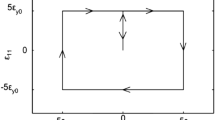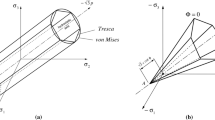Abstract
Integrating the constitutive equations in plasticity in order to update the stresses is the most important part of an elastoplastic finite element analysis. Here, a von-Mises plasticity model along with the isotropic and kinematic hardenings is taken into account in the small strain realm. An accurate integration is formulated by converting the differential constitutive equations into an augmented stress space and utilizing the return mapping algorithm. Subsequently, a broad range of numerical tests are performed to investigate the accuracy and performance of the proposed integration. The results demonstrate the robustness of the new integration scheme.
















Similar content being viewed by others
References
Artioli E, Auricchio F, Beirão da Veiga L (2005) Integration scheme for von-Mises plasticity models based on exponential maps: numerical investigations and theoretical considerations. Int J Numer Methods Eng 64(9):1133–1165
Artioli E, Auricchio F, Beirão da Veiga L (2006) A novel ‘optimal’ exponential-based integration algorithm for von-Mises plasticity with linear hardening: theoretical analysis on yield consistency, accuracy, convergence and numerical investigations. Int J Numer Methods Eng 67(4):449–498
Artioli E, Auricchio F, Beirão da Veiga L (2007) Second-order accurate integration algorithms for von-Mises plasticity with a nonlinear kinematic hardening mechanism. Comput Methods Appl Mech Eng 196(9):1827–1846
Auricchio F, Beirão da Veiga L (2003) On a new integration scheme for von-Mises plasticity with linear hardening. Int J Numer Methods Eng 56(10):1375–1396
Hong H-K, Liu C-S (1999) Internal symmetry in bilinear elastoplasticity. Int J Non-Linear Mech 34(2):279–288
Hong H-K, Liu C-S (2000) Internal symmetry in the constitutive model of perfect elastoplasticity. Int J Non-Linear Mech 35(3):447–466
Kobayashi M, Ohno N (2002) Implementation of cyclic plasticity models based on a general form of kinematic hardening. Int J Numer Methods Eng 53(9):2217–2238
Kojić M (1996) The governing parameter method for implicit integration of viscoplastic constitutive relations for isotropic and orthotropic metals. Comput Mech 19(1):49–57
Kojić M, Bathe KJ (1987) The “effective stress-function” algorithm for thermo-elasto-plasticity and creep. Int J Numer Methods Eng 24:1509–1532
Kojić M, Bathe KJ (2005) Inelastic analysis of solids and structures. Springer, Berlin
Liu C-S (2004) International symmetry groups for the Drucker–Prager material model of plasticity and numerical integrating methods. Int J Solids Struct 41(14):3771–3791
Liu C-S, Liu L-W, Hong H-K (2016) A scheme of automatic stress-updating on yield surfaces for a class of elastoplastic models. Int J Non-Linear Mech 85:6–22
Rezaiee-Pajand M, Nasirai C (2007) Accurate integration scheme for von-Mises plasticity with mixed-hardening based on exponential maps. Eng Comput 24(6):608–635
Rezaiee-Pajand M, Nasirai C (2008) On the integration scheme for Drucker–Prager’s elastoplastic models based on exponential maps. Int J Numer Methods Eng 74(10):799–826
Rezaiee-Pajand M, Sharifian M (2011) A novel formulation for integrating nonlinear kinematic hardening Drucker–Prager’s yield condition. Eur J Mech A/Solids 31(1):163–178
Rezaiee-Pajand M, Nasirai C, Sharifian M (2010) Application of exponential-based methods in integrating the constitutive equations with multi-component nonlinear kinematic hardening. ASCE J Eng Mech 136(12):1502–1518
Rezaiee-Pajand M, Nasirai C, Sharifian M (2011a) Integration of nonlinear mixed hardening models. Multidiscip Model Mater Struct 7(3):266–305
Rezaiee-Pajand M, Sharifian M, Sharifian M (2011b) Accurate and approximate integrations of Drucker–Prager plasticity with linear isotropic and kinematic hardening. Eur J Mech A/Solids 30(3):345–361
Rezaiee-Pajand M, Sharifian M, Sharifian M (2013) Integrating the pressure-sensitive nonassociative plasticity by exponential-based methods. ASME J Eng Mater Technol 135:1–22
Rezaiee-Pajand M, Auricchio F, Sharifian M, Sharifian M (2014a) Computational plasticity of mixed hardening pressure-dependency constitutive equations. Acta Mech 255:1699–1733
Rezaiee-Pajand M, Sharifian M, Sharifian M (2014b) Angles based integration for generalized non-linear plasticity along with application of optimal implicit SSP Runge–Kutta methods. Int J Mech Sci 87:241–257
Rezaiee-Pajand M, Auricchio F, Sharifian M, Sharifian M (2015) Exponential-based integration for Bigoni–Piccolroaz plasticity model. Eur J Mech A/Solids 51:107–122
Simo JC, Taylor RL (1986) A return mapping algorithm for plane stress elastoplasticity. Int J Numer Methods Eng 22(3):649–670
Zhang M, Benítez JM, Montnás FJ (2018) Cyclic plasticity using Prager’s translation rule and both nonlinear kinematic and isotropic hardening: theory, validation and algorithmic implementation. Comput Methods Appl Mech Eng 328:565–593
Author information
Authors and Affiliations
Corresponding author
Appendix
Appendix
For the sake of the convenience in using the presented algorithm in the computational implementations, the entries of the vectors and matrixes are given in the following:
At the end, the entries of the matrix \({\mathbf{\bar{\mathbb{G}}}}_{\text{p}}\) can be easily obtained by using the above vector.
Rights and permissions
About this article
Cite this article
Haji Aghajanpour, N., Sharifian, M. & Sharifian, M. An Efficient Method for Integrating von-Mises Plasticity with Mixed Hardening. Iran J Sci Technol Trans Mech Eng 44, 47–59 (2020). https://doi.org/10.1007/s40997-018-0248-8
Received:
Accepted:
Published:
Issue Date:
DOI: https://doi.org/10.1007/s40997-018-0248-8




